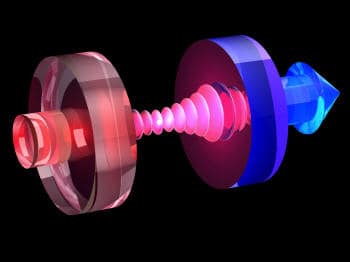Physicists in Germany have developed a new technique to cool atoms with lasers. The method is applied to single atoms trapped in an optical cavity and is five times faster than conventional laser cooling techniques. Moreover, unlike existing techniques, it preserves the quantum state of the atoms. The new approach could be used to cool molecules and other systems that cannot be laser-cooled by conventional methods, and could also have applications in quantum information (P Maunz et al. 2004 Nature 428 50).

Conventional laser cooling of atoms relies on photons exciting the electrons inside the atom. When the electron falls back into the ground state, the atom spontaneously emits a photon. Since this photon is emitted in a random direction, the overall effect of the absorption and emission process is to reduce the momentum of the atom – that is, to “cool” it – in the direction of the laser beam. This random emission removes heat from the system and so cools the atoms down.
The cavity-cooling technique developed by Gerhard Rempe and colleagues at the Max Planck Institute for Quantum Optics in Garching is different. First, it avoids spontaneous emission. Second, the atoms and the photons in the cavity are strongly coupled.
Rempe and co-workers start by trapping single atoms of rubidium in a tiny optical cavity between two mirrors. Next, they use a probe laser to excite the cavity, rather than the atom. Photons from the laser then escape from the cavity with slightly more energy than they had when they entered.
The strong coupling between the atom and the cavity means that the extra energy carried away by the scattered laser photons comes from the kinetic energy of the atom, which causes it to slow down or become cooler. Moreover, exciting the cavity – rather than an atom – ensures that the internal quantum state of the atom does not change, which could make it possible to process quantum information stored in atoms.
“Our cooling method allows us to localize and hold an atom in the cavity for longer times,” team member Pepijn Pinkse told PhysicsWeb. “This will allow us to perform detailed studies that were not possible before.”


